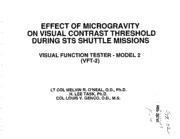
NASA Technical Reports Server (NTRS) 19930019552: Effect of microgravity on visual contrast threshold during STS Shuttle missions: Visual Function Tester-Model 2 (VFT-2) PDF
Preview NASA Technical Reports Server (NTRS) 19930019552: Effect of microgravity on visual contrast threshold during STS Shuttle missions: Visual Function Tester-Model 2 (VFT-2)
EFFECT OF MICROGRAVITY ON VISUAL CONTRAST THRESHOLD DURING STS SHUTTLE MISSIONS VISUAL FUNCTION TESTER MODEL 2 = (VFT-2) LT COL MELVIN Rm O'NEAL, OwDmPhm, Dm H. LEE TASK, PhwDm COL LOUIS V. GENCO, OmD.9 MmSw PURPOSE (VFT-2) Previous contrast threshold studies, both U.S. and Soviet, at different test distances and may be affected by age, lighting, and method of target presentation Determine effect of microgravity on distance visual contrast threshold over mission duration Use variable contrast adjustment device under controlled lighting condition to obtain more precise threshold measurement Testatmultiplespatialfrequenciesandwithadditional target types to more completely evaluate UNIFYING NORMAL VlSlON i VISUAL HETINA LGN CORTEX / VISUAL ABNORMAL VlSlON ;T STANDARDS I THRESHOLD AND IMPROVED SUPRATHRESHOLD VlSlON TARGET ACQUISITION AND IMAGE PROCESSING +'m . ..' '. i .. --. * ,', ... ,.' ,f' - + + t C \ -- - . - .- - ORIGINAL CONTRAST BASIC FORM .. . IDENTIF"'IyC- ATION DETAILS: TEXTURE +EDGES METHODS (VFT-2) SUBJECTS 5 Flights, 12 STS Astronauts -- 3 subjects with no post flight data -- 1 uncorrected (no glasses) -- 1 SCL, 1 Toric-SCL APPARATUS - Visual Function Tester Model 2 (VFT-2) -- Small, hand-held, battery powered -- Three target types: - Square-wave gratings (detection task) - Disks (detection task) - Tribars (orientation task) PROCEDURE SAME AS VFT-1 . RESULTS VISUAL CONTRAST THRESHOLD Insufficient number of subjects for report at this time VFT-2 manifested on STS-53 (2 astronauts) scheduled to fly Dec 92 Preliminary reporting of visual psychophysical study may affect subsequent data and should be avoided
